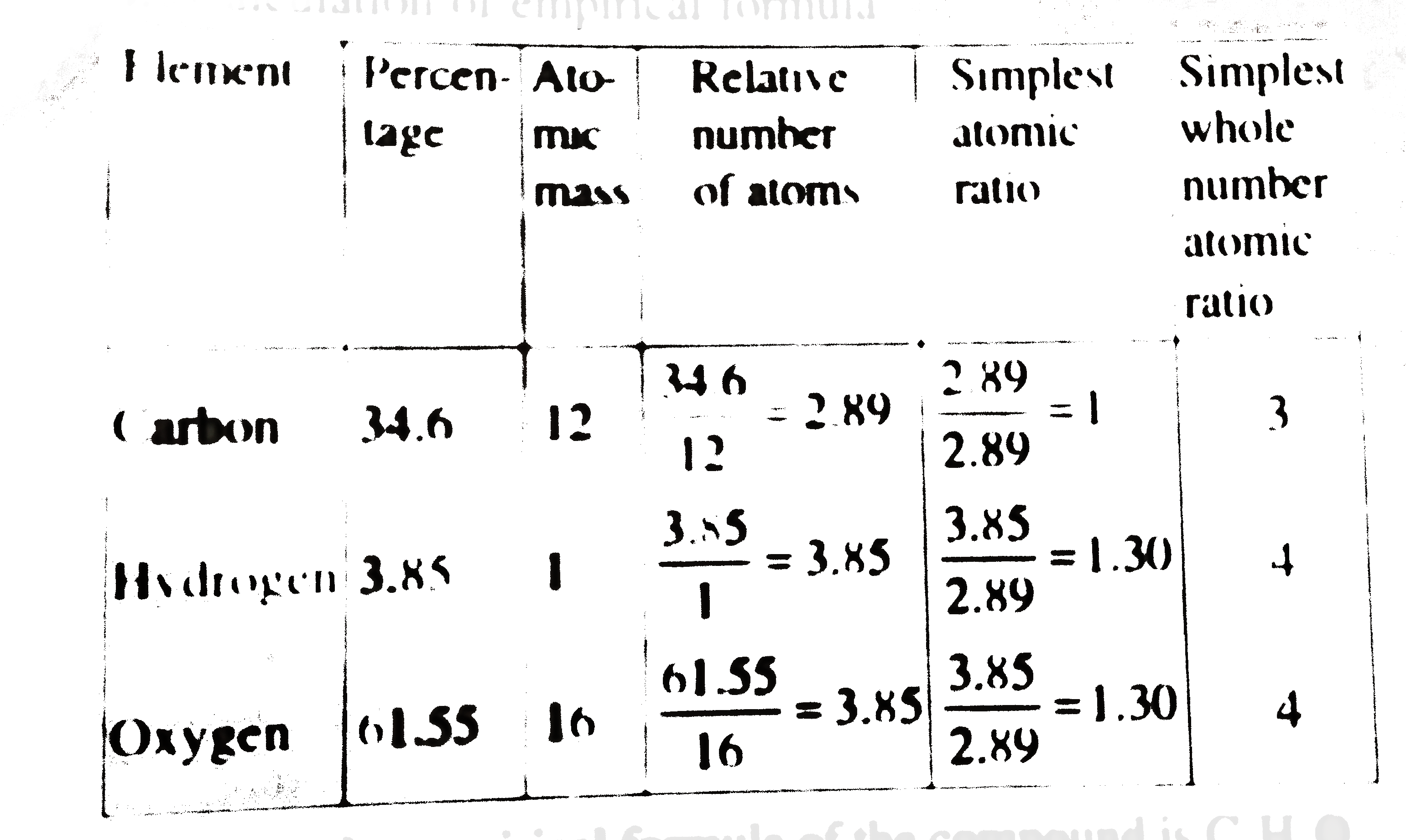An acid of molecular mass 104 contains 34.6% carbon and 3.85% hydrogen. 3.812 mg of the acid required 7.33 cm of 0.01 N NaOH for neutralisation. Suggest a structure for the acid.
percentage composition of elements
(i) percentage of carbon =34.6 (given)
(ii). Percentage of hydrogen =3.85 (given)
(iii). Percentage of oxygen
=100-(percentage of C+ percentage of H)
=100−(34.6+3.85)=61.55
(b).
(c). Calculation of the molecular formula of the acid: Empirical formula (C3H3O4) mass of the acid
=3×12+4×1+4×16=104 (given)
but molecular mass of the acid =104 (given)
n=Molecular formula massEmpirical formula mass=104104=1
Molecular formula of the acid
=n×(Empirical formula)=1×(C3H4O4)=C3H4O4
(d). Calculation of the basicity of the acid:
mEq. of NaOH=7.33×0.01 mEq. of acid =0.0733
=0.0733
Equivalelnt of acid =0.0733×10−3
equivalent of acid =weightEw
Ew of acid =weightEquivalentof acid=3.812×10−3gm0.0733×10−3
=≈52gm
basicity (n)=molecular massequivalent=10452=2
(e). Structure of the acid:
The acidic character of an organic acid is due to the presence of a corboxylic group (−COOH) as the functional group Since the basicity of the acid is 2, the given acid contains two (−COOH) groups. OUt of the molecular formula (C3H4O4),2×C))H=C2H2O4 is accounted for by the two carboxylic groups. rest of molecule of the acid =(C3H4O4−C2H2O4)
=CH2
Thus, the structure of the acid is CH2(COOH)2, i.e., malonic acid.

Topper's Solved these Questions
- PURIFICATION OF ORGANIC COMPOUNDS AND QUALITATIVE AND QUANTITATIVE ANALYSISBOOK - CENGAGE CHEMISTRY ENGLISHCHAPTER - PURIFICATION OF ORGANIC COMPOUNDS AND QUALITATIVE AND QUANTITATIVE ANALYSISEXERCISE - SOLVED EXAMPLES
17 Videos
- PURIFICATION OF ORGANIC COMPOUNDS AND QUALITATIVE AND QUANTITATIVE ANALYSISBOOK - CENGAGE CHEMISTRY ENGLISHCHAPTER - PURIFICATION OF ORGANIC COMPOUNDS AND QUALITATIVE AND QUANTITATIVE ANALYSISEXERCISE - Subjective Type
11 Videos
- PERIODIC CLASSIFICATION OF ELEMENTS AND GENERAL INORGANIC CHEMISTRYBOOK - CENGAGE CHEMISTRY ENGLISHCHAPTER - PERIODIC CLASSIFICATION OF ELEMENTS AND GENERAL INORGANIC CHEMISTRYEXERCISE - Exercises (Archives )Subjective
4 Videos
- REDOX REACTIONSBOOK - CENGAGE CHEMISTRY ENGLISHCHAPTER - REDOX REACTIONSEXERCISE - Archives (Integers)
1 Videos
Similar Questions
0.14 gm of an acid required 12.5 ml of 0.1 N NaOH for complete neuturalisation.The equivalent mass of the acid is:
View Solution0.126 g of acid required 20 mL of 0.1 N NaOH for complete neutralisation. The equivalent mass of an acid is
View Solution0.2 g of a monobasic acid gave 0.5 g of CO2 and 0.089 g of H2O. 0.122 g of the same acid requires 10 mL of 0.1 N NaOH for complete neutralisation. Determine the molecular formula of the compound.
View SolutionA monobasic acid has 68.9% C and 4.8% H. 0.122 g of acid require 10 mL of N/10 caustic soda solution for neutralisation. What is the molecular formula of the compound?
View Solution0.303 g of an organic compound was analysed for nitrogen by Kjeldahl's method. The ammonia evolved was absorbed in 50 ml of 0.1 N H2SO4. The excess acid required 25 ml of 0.1 N NaOH for neutralisation. Calculate the percentage of nitrogen in the compound.
View Solution0.075 g of a monobasic acid required 10 mL of N/12NaOH solution for complete neutralisation. Calculate the molecular mass of the acid
View Solution0.16 g of dibasic acid required 25 ml of decinormal NaOH solution for complete neutralisation. The molecular weight of the acid will be
View Solution0.16 gm of a dibasic organic acid required 25.0 ml of N10NaOH for complete neutralisation. Calculate its molucular mass.
View SolutionAn organic compound contains 69.4% carbon and 5.8% hydrogen. A sample of 0.303 g of this compound was analysed for nitrogen by Kjeldahl's method. The ammonia evolved was absorbed in 50 mL of 0.05 M H2SO4. The excess acid required 25 mL of 0.1 M NaOH for neutralisation. Determine the molecular formula of the compound, if its molecular mass is 121.
View Solution0.45 g of a dibasic acid on combustion gave 0.44 g of CO2 and 0.09 g H2O. The molecular mass of the acid is 90. Calculate the molecular formula. Suggest a structure for the acid.
View Solution
